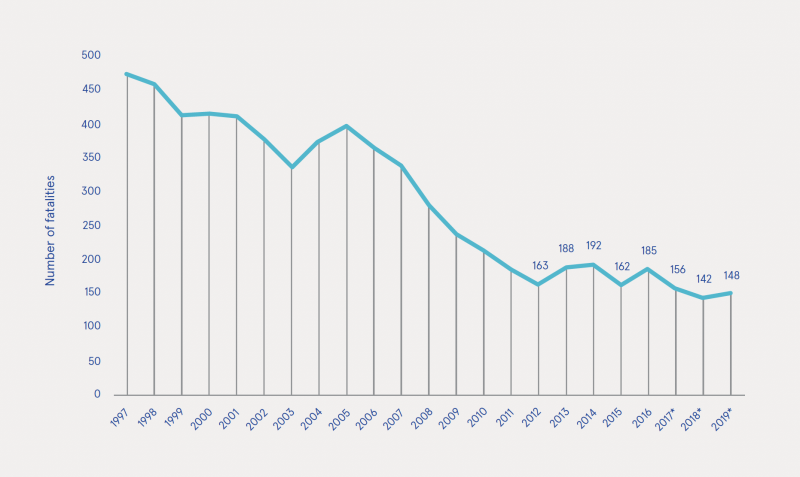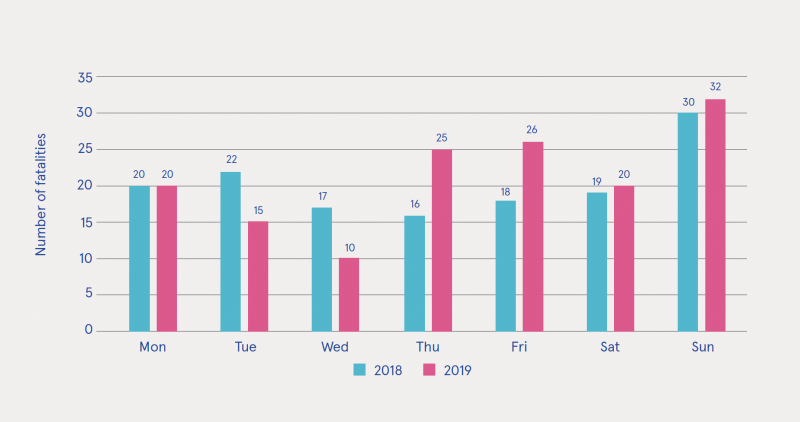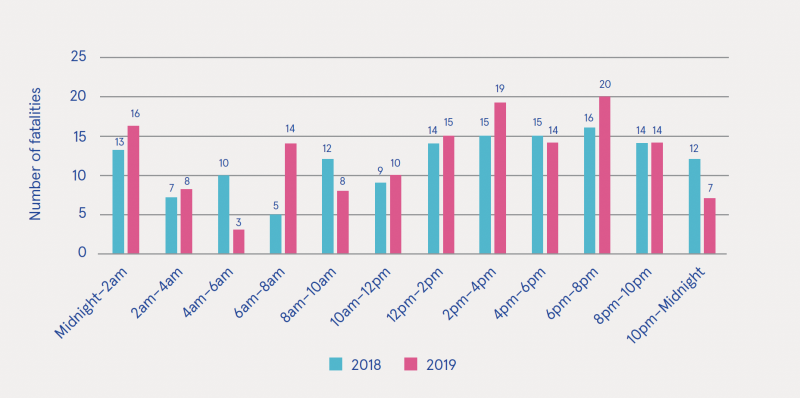Guiney, Ciara (2020) Provisional review of road collision fatalities. Drugnet Ireland, Issue 73, Spring 2020, pp. 13-15.
| Preview | Title | Contact |
|---|---|---|
|
PDF (Drugnet Ireland 73)
758kB |
On 3 January 2020, the Road Safety Authority (RSA) published a provisional review of fatal collisions for 2019.1,2 The report is the result of analysis of fatality data received from An Garda Síochána. The results in this analysis are provisional and may be subject to change. The report first provides an overview followed by more in-depth analysis by month of year; day of week; time of day; where fatalities occurred; age profile; road user type; and age profile by road user type. Drugs were not mentioned in this analysis.
Overview
Figure 1 shows the trends in fatalities from 1997 to 2019. In 2019, 148 fatalities arose from 137 collisions on Irish roads.
Month of year
The highest number of fatalities were reported in March 2017 (n=20) and September 2019 (n=20). The lowest number of fatalities were reported in May 2018 (n=5). In 2019, the most dangerous month was September (n=20), followed by December (n=16), January (n=14), and February (n=14).
Day of week and time of day
Figures 2 and 3 show what day of the week and what time of day the fatalities occurred. The highest number of fatalities was reported for Sunday in both 2018 and 2019. The data for 2019 were higher for Thursday, Friday, Saturday, and Sunday when compared with 2018. Tuesday and Wednesday were shown to have the lowest number of fatalities in 2019; these figures were lower than those reported in 2018.
Data for 2019 indicated that the worst time for fatalities in Ireland was between 6pm and 8pm followed closely by 2pm–4pm, midnight–2am, and 12pm–2pm (see Figure 3).
Weekdays between 12pm and 8pm showed the highest fatalities, while the lowest fatality was reported at weekends between 8am and 12pm.

Figure 1: Number of fatalities by year, 1997–2019
Source: RSA (2020), Figure 1, p. 1
*2017–2019 data are provisional and subject to change.

Figure 2: Number of fatalities by day of week, 2018–2019
Source: RSA (2020), Figure 4, p. 5
Note: 2018–2019 data are provisional and subject to change.

Figure 3: Number of fatalities by time of day, 2018–2019
Source: RSA (2020), Figure 5, p. 6
Note: 2018–2019 data are provisional and subject to change.
Where fatalities occurred
Fatalities in 2018 and 2019 were more likely to occur in rural areas.
Fatalities by speed limit
The highest number of fatalities occurred within an 80 km/h speed limit followed by 100 km/h. A large percentage increase (45%), which occurred within the 80 km speed limit, was evident between 2018 and 2019.
Age profile
Fatalities were reported in all age categories. The majority of individuals who died on Irish roads during this timeframe were aged over 66 years. Between 2018 and 2019, there was a substantial increase (56%) in deaths in individuals aged between 26 and 35 years, while a 21% increase was evident in individuals aged 66 years or over.
Road user type
Across this timeframe the majority of individuals that died were drivers. Between 2018 and 2019, the number of drivers that died increased by 45%. The overall fatality figures in 2019 were slightly higher than 2018 figures; two more fatal collisions were evident, which resulted in a 4% increase in deaths (n=6). Fortunately, the number of pedestrian fatalities decreased by 36% (n=15); however, there was a substantial increase in driver fatalities (45%, n=25).
Age profile by road user type
In 2019, drivers aged 66+ years (n=23), followed by those aged 26–35 years (n=19), and aged 16–25 years (n=12) were more likely to die on Irish roads.
Conclusion
The findings in this report will be used to inform policies and practices with the overall aim of reducing road fatalities. The Minister for Transport, Tourism and Sport, Shane Ross TD, expressed deepest condolences to the families of those who died on Irish roads. He acknowledged that the only response was via ‘action not words’ and emphasised the importance of ‘continuing to implement life saving measures contained in the Road Safety Strategy’.3
The Minister went on to say that:
As ordinary road users … we need to take greater responsibility for our actions …. we can do this by slowing down, not driving while impaired through drink, drugs or fatigue, by not driving while using a phone, by wearing a seatbelt and always sharing the road more carefully with pedestrians and cyclists.3
1 Road Safety Authority (RSA) (2020) Provisional review of fatal collisions: 1 January to 31 December 2019. Dublin: Road Safety Authority. Available online at: https://www.rsa.ie/Documents/Fatal%20Collision%20Stats/Provisional_Reviews_of_Fatal_Collisions/RRD_Res_20191231_RSAProvisionalReviewFatalities31December2019_03Jan2020.pdf
2 Road Safety Authority (RSA) (2020) Provisional review of fatal collisions: January to 31 December 2019. Dublin: Road Safety Authority. https://www.drugsandalcohol.ie/31513/
3 Road Safety Authority (2020) 4% rise in road deaths recorded in 2019. Dublin: Road Safety Authority. Available online at:
https://www.rsa.ie/ga-IE/Utility/Nuacht/2020/4-Rise-in-Road-Deaths-Recorded-in-2019/
Repository Staff Only: item control page